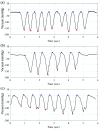Non-Nutritive Suckling System for Real-Time Characterization of Intraoral Vacuum Profile in Full Term Neonates
- PMID: 36619906
- PMCID: PMC9815562
- DOI: 10.1109/JTEHM.2022.3231788
Non-Nutritive Suckling System for Real-Time Characterization of Intraoral Vacuum Profile in Full Term Neonates
Abstract
Infant breastfeeding diagnostics remain subjective due to the absence of instrumentation to objectively measure and understand infant oral motor skills and suckling characteristics. Qualitative diagnostic exams, such as the digital suck assessment which relies upon a clinician's gloved finger inserted into the infant's mouth, produce a diversity of diagnoses and intervention pathways due to their subjective nature. In this paper, we report on the design of a non-nutritive suckling (NNS) system which quantifies and analyzes quantitative intraoral vacuum and sucking patterns of full-term neonates in real time. In our study, we evaluate thirty neonate suckling profiles to demonstrate the technical and clinical feasibility of the system. We successfully extract the mean suck vacuum, maximum suck vacuum, frequency, burst duration, number of sucks per burst, number of sucks per minute, and number of bursts per minute. In addition, we highlight the discovery of three intraoral vacuum profile shapes that are found to be correlated to different levels of suckling characteristics. These results establish a framework for future studies to evaluate oromotor dysfunction that affect the appearance of these signals based on established normal profiles. Ultimately, with the ability to easily and quickly capture intraoral vacuum data, clinicians can more accurately perform suckling assessments to provide timely intervention and assist mothers and infants towards successful breastfeeding outcomes.
Keywords: Breastfeeding; diagnostics; instrument; intraoral vacuum; pacifier; pressure sensor.
Figures






Similar articles
-
Application of Statistical Analysis and Machine Learning to Identify Infants' Abnormal Suckling Behavior.IEEE J Transl Eng Health Med. 2024 Apr 17;12:435-447. doi: 10.1109/JTEHM.2024.3390589. eCollection 2024. IEEE J Transl Eng Health Med. 2024. PMID: 38765888 Free PMC article.
-
Changes in infant non-nutritive sucking throughout a suck sample at 3-months of age.PLoS One. 2020 Jul 9;15(7):e0235741. doi: 10.1371/journal.pone.0235741. eCollection 2020. PLoS One. 2020. PMID: 32645061 Free PMC article.
-
Altered sucking dynamics in a breastfed infant with Down syndrome: a case report.Int Breastfeed J. 2020 Aug 15;15(1):71. doi: 10.1186/s13006-020-00318-4. Int Breastfeed J. 2020. PMID: 32799897 Free PMC article.
-
[Development of a child's eating and urge for suckling].Duodecim. 2013;129(5):473-9. Duodecim. 2013. PMID: 23520890 Review. Finnish.
-
Abnormal Nutritive Sucking as an Indicator of Neonatal Brain Injury.Front Pediatr. 2021 Jan 12;8:599633. doi: 10.3389/fped.2020.599633. eCollection 2020. Front Pediatr. 2021. PMID: 33511093 Free PMC article. Review.
Cited by
-
Application of Statistical Analysis and Machine Learning to Identify Infants' Abnormal Suckling Behavior.IEEE J Transl Eng Health Med. 2024 Apr 17;12:435-447. doi: 10.1109/JTEHM.2024.3390589. eCollection 2024. IEEE J Transl Eng Health Med. 2024. PMID: 38765888 Free PMC article.
-
Non-Nutritive Suck Parameters Measurements Using a Custom Pressure Transducer System.J Vis Exp. 2024 Apr 19;(206):10.3791/66273. doi: 10.3791/66273. J Vis Exp. 2024. PMID: 38709051 Free PMC article.

